On April 8…
“I think we have gone through a period when too many children and people have been given to understand “I have a problem, it is the Government’s job to cope with it! Life is a reciprocal business and people have got the entitlements too much in mind without the obligations.”
~Margaret Thatcher

1820 – The Venus de Milo was discovered on the Aegean island of Milos by farmer Theodoros Kendrotas who was taking stone from a ruined chapel.
Created sometime between 130 and 100 BC, it is thought to be the work of Alexandros of Antioch although it was initially attributed to the master sculptor Praxiteles.
The statue is believed to depict Aphrodite, the Greek goddess of love and beauty (Venus to the Romans). It stands slightly larger than life size at 6′ 8″. The arms and plinth (pedestal) were lost following its discovery.
The photo above shows the statue now (on permanent display at the Louvre Museum in Paris) and a reconstruction based on a proposed restoration sketch from 1895, incorporating statue fragments found at the original site.
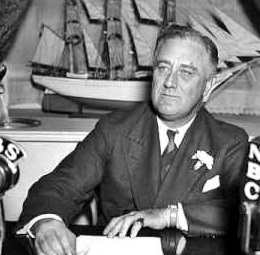
1943 – President Franklin D. Roosevelt signed Executive Order 9328.
The order was seen as a direct response to a United Mine Workers strike, in which they had demanded better pay and better job prospects. It was also seen as a warning to unions that further strikes and protests would not be tolerated.
The order froze the prices on anything in the country that could affect the cost of living (which essentially was everything.) It also prohibited any increase in wages and did not permit anyone to change their jobs unless the U.S. war effort would be aided.
The order controlled Americans to the extent that they were told how much to pay for everything they bought, where they were allowed to work, and how much they should be paid.
Despite its controversial nature, the order received little or no challenges from the courts or the American public.
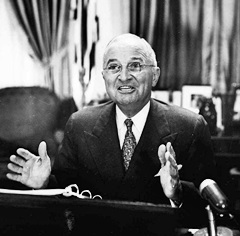
1952 – President Harry S. Truman seized the steel industry to avert a nationwide strike by the United Steelworkers of America against U.S. Steel and nine other steelmakers.
Truman nationalized the American steel industry hours before the workers walked out. The steel companies sued to regain control of their facilities. In a landmark decision two months later, the U.S. Supreme Court ruled in Youngstown Sheet & Tube Co. v. Sawyer, that the president lacked the authority to seize the steel mills.
Once the ruling had been delivered, the mills were immediately returned to their owners. The Steelworkers went on strike a few hours later. The strike lasted 53 days, and ended on essentially the same terms the union had proposed months earlier.

1963 – At the 35th Academy Awards, Lawrence of Arabia, with ten nominations, captured seven Oscars, including Best Picture and Best Director.
Anne Bancroft won the Best Actress award for her performance in The Miracle Worker and Gregory Peck won Best Actor for his amazing performance in To Kill A Mockingbird.
16-year old Patty Duke won Best Supporting Actress for her role in The Miracle Worker, making her the youngest person at that time to have received an Academy Award in a competitive category.

1974 – At Atlanta–Fulton County Stadium, Hank Aaron hit his 715th career home run to surpass Babe Ruth’s 39-year-old record.
As the 1974 season began, Aaron’s pursuit of the record caused a small controversy. The Braves opened the season on the road in Cincinnati. Braves management wanted him to break the record in Atlanta, and were going to have Aaron sit out the first three games of the season.
Baseball Commissioner Bowie Kuhn ruled that he had to play two games in the first series. He played two out of three, tying Babe Ruth’s record on April 4, 1974 in his very first at bat – his first swing of the season – but did not hit another home run in the series.
In the fourth inning of the home opener, Aaron hit home run number 715 off Los Angeles Dodgers pitcher Al Downing and Dodgers broadcaster Vin Scully described it as only he could.
What a marvelous moment for baseball; what a marvelous moment for Atlanta and the state of Georgia; what a marvelous moment for the country and the world. A black man is getting a standing ovation in the Deep South for breaking a record of an all-time baseball idol. And it is a great moment for all of us, and particularly for Henry Aaron.”
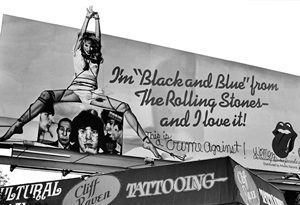
1976 – Women Against Violence Against Women called for a boycott of Warner Communications albums because of the promotional campaign for the Rolling Stones’ new album, Black And Blue.
A campaign billboard placed on Sunset Boulevard featured a half-naked, bruised and bound woman and the accompanying caption of “I’m ‘Black and Blue’ from the Rolling Stones – and I love it!”
Stones lead singer Mick Jagger was unrepentant.
“There are a lot of girls into that, they dig it, they want to be chained up and it’s a thing that’s true for both sexes. I don’t see why we can’t use it to advertise a record. It’s a valid piece of commercial art, it’s just a picture.”
The billboard came down.
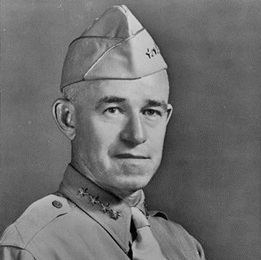
1981 – Gen. Omar Bradley, the first Chairman of the Joint Chiefs of Staff and a 5-star General, died of cardiac arrhythmia at the age of 88.
During World War II, he took command of the Twelfth United States Army Group, which ultimately comprised forty-three divisions and 1.3 million men, the largest body of American soldiers ever to serve under a single field commander.
During the Korean War, he was instrumental in persuading President Harry Truman to dismiss General Douglas MacArthur in 1951 after MacArthur resisted administration attempts to scale back that war’s strategic objectives.
Following MacArthur’s dismissal, Bradley testified before Congress and said, “Frankly, in the opinion of the Joint Chiefs of Staff, (MacArthur’s) strategy would involve us in the wrong war, at the wrong place, at the wrong time, and with the wrong enemy.”

1990 – Ryan White, an AIDS patient whose battle for acceptance gained national attention, died at the age of 18.
As a hemophiliac, White became infected with HIV from a contaminated factor VIII blood treatment and, when diagnosed in December 1984, was given six months to live.
Although doctors said he posed no risk to other students – as AIDS is not an airborne disease – many parents and teachers rallied against his attendance due to concerns of the disease spreading through bodily fluid transfer.
Western Middle School in Russiaville faced enormous pressure from many parents and faculty to prevent White from returning to school. In the school of 360 total students, 117 parents and 50 teachers signed a petition encouraging school leaders to ban White from school. Due to the widespread fear and ignorance of AIDS, the principal and later the school board succumbed to this pressure and prohibited re-admittance.
A lengthy administrative appeal process ensued – he was allowed back in April 1986 – and news of the conflict turned Ryan into a popular celebrity and advocate for AIDS research and public education. Surprising his doctors, Ryan White lived five years longer than predicted.
He died one month before his high school graduation.
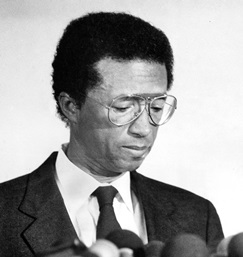
1992 – Retired tennis legend Arthur Ashe announced that he had AIDS, acquired from blood transfusions during one of his two heart surgeries.
Ashe and his wife decided to keep his illness private for the sake of their daughter, who was then two years old, but when he discovered USA Today planned to run a story about Ashe’s illness, he went public before the article was published.
He founded the Arthur Ashe Foundation for the Defeat of AIDS, working to raise awareness about the virus and advocated teaching sex education and safe sex.
In a speech to the United Nations General Assembly on World AIDS Day, December 1, 1992, he addressed the growing need for AIDS awareness and increased research funding saying “We want to be able to look back and say to all concerned that we did what we had to do, when we had to do it, and with all the resources required.”
On February 6, 1993, Ashe died from AIDS-related pneumonia at New York Hospital at the age of 49.

2009 – Four Somali pirates hijacked the U.S.-flagged Maersk Alabama 240 nautical miles southeast of Eyl, Somalia.
It was the first successful pirate seizure of a ship registered under the American flag since the early 19th century. The siege ended after a rescue effort by the U.S. Navy four days later.
The hijacking inspired the 2013 film Captain Phillips starring Tom Hanks.

2013 – Actress/singer Annette Funicello died from complications due to multiple sclerosis. She was 70.
She rose to prominence as one of the most popular Mouseketeers on the original Mickey Mouse Club, then transitioned to a successful career as a singer with pop singles Tall Paul and Pineapple Princess.
During the mid-1960s, she starred in a series of successful ‘beach party’ movies with teen heartthrob Frankie Avalon, in such films as Beach Party, Bikini Beach, Beach Blanket Bingo, and How To Stuff A Wild Bikini.

2013 – Margaret Thatcher died at the age of 87, after suffering a stroke.
Prime Minister of the United Kingdom from 1979 to 1990, she was the longest-serving British prime minister of the 20th century and the first woman to hold that office.
A Soviet journalist dubbed her “The ‘Iron Lady'”, a nickname that became associated with her uncompromising politics and leadership style.
Compiled by Ray Lemire ©2019 RayLemire.com / Streamingoldies.com. All Rights Reserved.
